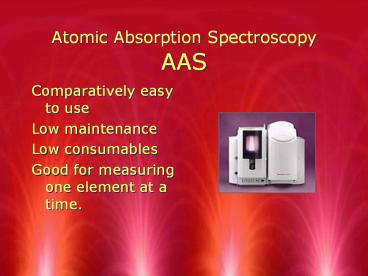Atomic Absorption Spectroscopy AAS - PowerPoint PPT Presentation
Title:
Atomic Absorption Spectroscopy AAS
Description:
Atomic Absorption Spectroscopy AAS Comparatively easy to use Low maintenance Low consumables Good for measuring one element at a time. Block Diagram hn + M M ... – PowerPoint PPT presentation
Number of Views:3697
Avg rating:3.0/5.0
Title: Atomic Absorption Spectroscopy AAS
1
Atomic Absorption Spectroscopy AAS
- Comparatively easy to use
- Low maintenance
- Low consumables
- Good for measuring one element at a time.
2
Block Diagram
- hn M ? M
- Sample is vaporized/atomized by
- Flame
- Electrothermal Vaporizer (ETV)
3
AA Sources- HCL
4
Flame AAS sample introduction
- Sample is dissolved into solution (usually
acidic). - Sample is pulled through straw into nebulizer.
Most of samples goes to waste. - Nebulizer sends droplets/aerosol to flame to be
de-solvated, resulting in gaseous molecules/atoms.
5
Flame processes
- To excited free atoms, flame must break any
molecules apart into discrete atoms. - Potential Problems
- Atoms recombine readily in flame, especially with
O2. - If flame is too energetic, ionization of atoms
can occur - wont be detected.
- MX (g) ? M (g) X(g)
- M O ? MO
- M ? M e-
6
Burner Head
- want a long optical pathlength.
7
Temperature of Some Flames
Fuel Oxidant Temperature (K)
H2 Air (20 O2, 80 N2) 2000-2100
C2H2 Air 2100-2400
H2 O2 2600-2700
C2H2 N2O 2600-2800
8
Electrothermal Vaporization
- First demonstrated in 1961 by L'vov (USSR)
- Use electrically heated carbon furnace
- Excellent LOD
More sensitive than flame Entire sample
atomized at once Residence time of vapor in
optical path gt1 s
Potential problem poor precision due to
sampling variability
LOD for Mg Flame 0.1 ppm ETV 0.00002 ppm - 20
pptr
9
Cold Vapor (CV) Atomization
- Mercury
- Reduced by SnCl2
10
Physical Interferences
- Droplet size from nebulizer depends on surface
tension of solution. - Organic solvent (alcohol, ester, ketone) can lead
to smaller droplets, more intense signal.
11
Chemical Interferences
- Formation of compounds of low volatility, ex.
CaSO4 - Ionization
- M ? M e-
- Add ionization suppressors - create electron-rich
environments. Ex, alkali metals
12
Spectral Interferences
- Two or more lines within monochromators spectral
bandpass - requires appropriate resolution from
diffraction grating (line spacing)
Mn 403.31 nm K 404.40 nm Ga 403.30 nm
13
Double-Beam Instrument
- A reference beam is used as a blank signal.
- To get T measurement, you have to know what the
measurement for 100 T is. - Because the flame is always fluctuating, we need
the reference beam to give a point of reference
at any time during experiment - compensates for
drift.
14
Background Correction
- Flame creates a messy background - scattering,
absorbance by molecular species (oxides,
hydroxides) - Another wavelength is passed through the flame,
its T measured. - Any loss of T is due to scattering, losses
unrelated to absorption by analyte. - The analyte T is corrected for these losses.
15
Atomic Fluorescence Spectroscopy
Fundamental Process hn M ? M ? M hn'
Photon emitted is not the same energy as the
photon absorbed it has lower energy fluorescenc
e signal is directly proportional to
concentration Enhanced sensitivity over
AAS Signal collected at 90 angle - avoid having
to filter out source radiation
Fluorescence
16
Quantitative Analysis - Calibration Curve
- Test a series of standards and plot Abs v. conc,
find LDR - Run your sample and determine conc with line
equation.
ppm ?g/mL ppb ng/mL For aqueous solutions
(1 g/mL)
17
Quantitative Analysis - Standard Additions Method
- Spike your standards into your samples - its all
the same matrix. - cx bcs/mVx
- S standard
- X unknown
- From graph
- Cx -(x-int)cs/Vx































